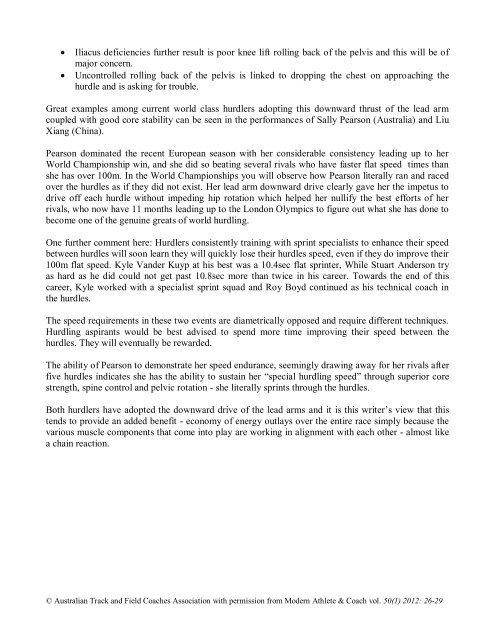Hurdle Performance: lead arm technique advancement - The ...
Hurdle Performance: lead arm technique advancement - The ...
Hurdle Performance: lead arm technique advancement - The ...
You also want an ePaper? Increase the reach of your titles
YUMPU automatically turns print PDFs into web optimized ePapers that Google loves.
Iliacus deficiencies further result is poor knee lift rolling back of the pelvis and this will be of<br />
major concern.<br />
Uncontrolled rolling back of the pelvis is linked to dropping the chest on approaching the<br />
hurdle and is asking for trouble.<br />
Great examples among current world class hurdlers adopting this downward thrust of the <strong>lead</strong> <strong>arm</strong><br />
coupled with good core stability can be seen in the performances of Sally Pearson (Australia) and Liu<br />
Xiang (China).<br />
Pearson dominated the recent European season with her considerable consistency <strong>lead</strong>ing up to her<br />
World Championship win, and she did so beating several rivals who have faster flat speed times than<br />
she has over 100m. In the World Championships you will observe how Pearson literally ran and raced<br />
over the hurdles as if they did not exist. Her <strong>lead</strong> <strong>arm</strong> downward drive clearly gave her the impetus to<br />
drive off each hurdle without impeding hip rotation which helped her nullify the best efforts of her<br />
rivals, who now have 11 months <strong>lead</strong>ing up to the London Olympics to figure out what she has done to<br />
become one of the genuine greats of world hurdling.<br />
One further comment here: <strong>Hurdle</strong>rs consistently training with sprint specialists to enhance their speed<br />
between hurdles will soon learn they will quickly lose their hurdles speed, even if they do improve their<br />
100m flat speed. Kyle Vander Kuyp at his best was a 10.4sec flat sprinter, While Stuart Anderson try<br />
as hard as he did could not get past 10.8sec more than twice in his career. Towards the end of this<br />
career, Kyle worked with a specialist sprint squad and Roy Boyd continued as his technical coach in<br />
the hurdles.<br />
<strong>The</strong> speed requirements in these two events are diametrically opposed and require different <strong>technique</strong>s.<br />
Hurdling aspirants would be best advised to spend more time improving their speed between the<br />
hurdles. <strong>The</strong>y will eventually be rewarded.<br />
<strong>The</strong> ability of Pearson to demonstrate her speed endurance, seemingly drawing away for her rivals after<br />
five hurdles indicates she has the ability to sustain her “special hurdling speed” through superior core<br />
strength, spine control and pelvic rotation - she literally sprints through the hurdles.<br />
Both hurdlers have adopted the downward drive of the <strong>lead</strong> <strong>arm</strong>s and it is this writer’s view that this<br />
tends to provide an added benefit - economy of energy outlays over the entire race simply because the<br />
various muscle components that come into play are working in alignment with each other - almost like<br />
a chain reaction.<br />
© Australian Track and Field Coaches Association with permission from Modern Athlete & Coach vol. 50(1) 2012: 26-29


